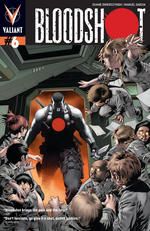"Bloodshot" #6 by Duane Swiercynski and Manual Garcia is best described a "combat maze" segment of an action story, like the last part of the TriWizard Tournament in "Harry Potter and the Goblet of Fire" and numerous other stories where the hero must fight through obstacles in a closed, artificial environment to reach a goal. It's a classic narrative technique (and video game scenario) to draw out suspense before a climax, and it still works here.
Bloodshot's internal dialogue begins sluggishly, stating the obvious about being fired at by enemies, but the rhythm and humor of Swiercynski's script for "Bloodshot" #6 quickly pick up when Bloodshot turns to "The Kid" for help. "The Kid" is a manifestation of nanites in Bloodshot's bloodstream, but the relationship between the two is not host/parasite but more like hero/smart-aleck sidekick. "The Kid" is smart and sarcastic, with a strong personality and abilities that give him presence outside Bloodshot's body.
The introductory conversation between Kara Walker and "The Kid" is the most funny meet-and-greet I've read in a while. I especially appreciated Kara's crack about Justin Bieber, and the interaction between the two feels like a great beginning to a team. Along the same lines, it's satisfying when Swiercynski puts Bloodshot in serious peril and the titular hero needs assistance from seemingly weaker allies. Swiercynski uses the supporting cast as contrasts to Bloodshot's height, strength and personality, and his dialogue serves each character well.
Swiercynski's villains for "Bloodshot" are not so as well developed, however, and the Chainsaw cannon fodder thrown at Bloodshot, Oreck and the other all-business suits at Project Rising Spirit are either monstrous-looking or flat, seemingly inhuman characters. Gamma is terrifying, but she's a type of bogey with a shock value that relies on the contrast between her caretaker status and sadistic personality. A similarly wrinkled and muscled man would be less humorous and less frightening in the same role. Garcia's character design for Gamma is creepy and disturbing, but also over-the-top.
Garcia's art matches the action of "Bloodshot" #6 nicely, getting across both the kinetic, relentless assault on Bloodshot and claustrophobic, windowless maze-space of the Project Rising Spirit facility. However, even with differently-colored tank tops and dialogue, Pulse/Melissa and Kara Murphy look too much alike. They have nearly identical bodies, outfits and hair, and they are stuck in nearly identical cells within the facility. The story is briefly confusing in the pages where the story lumps between the two women.
Colorist Ian Hannin does a great job in the scene where Bloodshot faces ice instead of fire. His pale faded blues and steam-like whites conveys freezing temperatures of this particular combat setting.
Swiercynski's plotting is typically slow to build, and six issues in, little is known about Bloodshot's original purpose and his past, but if the cliffhanger ending is any indication, the next issue will hit a payload of narrative revelations as the "Harbinger Wars" crossover event approaches.

